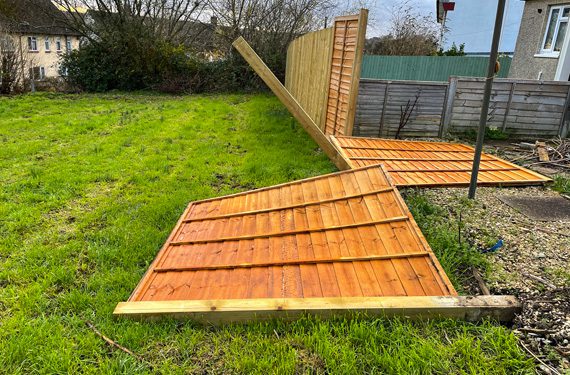All Categories
Featured
Fencings provide many benefits for home owners, consisting of privacy, safety, and boosting aesthetic appeal. Here are several vital signs that your fence may require to be replaced.
![]()
![]()
![]()
Final thought. Whether it's via physical damages, bug problems, rot, or simply the natural progression of time, recognizing the indicators that your fencing needs to be replaced can assist you make an enlightened choice about when to take action. By changing your fence at the appropriate time, you can guarantee that your building remains secure, visually appealing, and functional for years to come.
- Substantial Physical Damages. Physical damage to a fence can be triggered by various elements, consisting of severe weather, fallen trees, or accidents. Search for damaged, split, or missing areas of the fencing, specifically if they are numerous or impact the general structure. While individual repair work are often feasible, prevalent damages may suggest that a full substitute is more affordable. If several panels are broken, or the blog posts are entirely endangered, the fence will no longer serve its key objective of offering safety and security and privacy.

- Deteriorating and Degeneration. Over time, the rot can spread out throughout the fence, damaging its structural stability. While localized areas of decay may be fixed, if the rot is extensive, replacing the fence is normally the ideal choice.
- Leaning or Tilting. A leaning fencing is a clear indication that the posts might have been harmed or that the dirt around the articles has actually changed. Fences that turn dramatically may remain in threat of dropping over, developing a safety and security hazard. Changing dirt can take place due to various variables, such as erosion, tree root development, or ground settling. If the leaning is serious, or if efforts to correct the alignment of the blog posts have not worked, replacing the afflicted areas or the entire fencing may be required to preserve safety and security.
- Bug Infestation. Parasites such as ants, termites, and rodents can trigger serious damage to wooden fencings. In numerous situations, pest problems can compromise the fence to the factor where repair work will not be sufficient, and replacement may be needed.

- Rust or Rust (For Steel Fences) Steel fences, including chain-link, aluminum, and functioned iron, are prone to rust and rust, particularly in areas with high wetness or salt exposure. Gradually, rust can gnaw at the steel, weakening the structure and triggering the fencing to come to be unpredictable. Fixings may not be enough if the corrosion is extensive and impacting the integrity of the fencing. In this case, changing the steel areas or the entire fencing is the best option.
- Fading or Staining (For Plastic Fences) Plastic fencings are a prominent choice due to their reduced maintenance and resilience. If the fencing is showing signs of substantial fading, particularly if it influences the total look of your home, replacing it with a new vinyl fencing or a different product may improve both aesthetics and functionality.
- The Fencing is Outdated or No More Fulfills Your Needs. In some cases, the requirement to change a fence isn't because of damage, however due to the fact that it no more fits your requirements or the design of your home. If your fencing is outdated, doesn't provide enough personal privacy, or no longer uses the degree of safety you need, it might be time for an upgrade. Additionally, if your initial fence was developed for a particular objective, such as maintaining family pets in, and now you need a more strong barrier for privacy or safety, a replacement will make sure the fence serves your present needs.

- Constant Repair Service Costs. It might be extra cost-effective to replace the entire structure rather than continuously patching it up if you locate yourself regularly repairing areas of your fence. Frequent fixings can accumulate over time, and a fencing that calls for constant interest might not be giving the protection and functionality you need. A brand-new fence can conserve you cash in the lengthy run by minimizing continuous upkeep costs.
- Fence No Longer Offers Privacy or Protection. The main functions of several fencings are to supply personal privacy and protection. If your fence is no more offering these objectives-- whether because of spaces, deteriorated structure, or simply an out-of-date design-- it may need to be changed. A fencing that does not offer ample privacy can leave your home revealed, while a fencing that's no more protect can jeopardize the safety of your home.
- The Fence is Near completion of Its Life-span. If your fencing is approaching or surpassing this age and reveals several signs of wear, it's a great concept to begin preparing for a replacement. Also if the fence appears to be in decent condition, an old fence may be much more vulnerable to damages, and replacing it proactively can save you from dealing with unexpected problems down the road.
Final thought. Whether it's via physical damages, bug problems, rot, or simply the natural progression of time, recognizing the indicators that your fencing needs to be replaced can assist you make an enlightened choice about when to take action. By changing your fence at the appropriate time, you can guarantee that your building remains secure, visually appealing, and functional for years to come.
Latest Posts
Find Out Reduce Expenses on Car Maintenance with Montclare Auto Repair’s Special Deals
Published en
1 min read
Explore WyHy Federal Credit Union Maximizes Your Savings on Loans and Savings
Published en
1 min read
Explore Limited-Time Auto Repair Specials in Chicago at Montclare Auto Repair
Published en
1 min read
More
Latest Posts
Find Out Reduce Expenses on Car Maintenance with Montclare Auto Repair’s Special Deals
Published May 23, 25
1 min read
Explore WyHy Federal Credit Union Maximizes Your Savings on Loans and Savings
Published May 22, 25
1 min read
Explore Limited-Time Auto Repair Specials in Chicago at Montclare Auto Repair
Published May 21, 25
1 min read